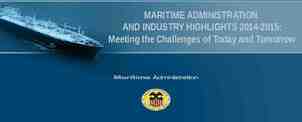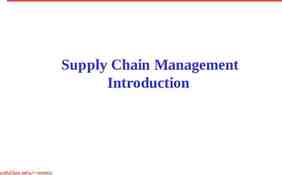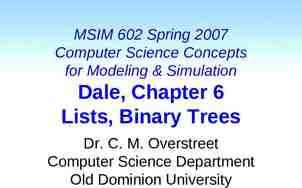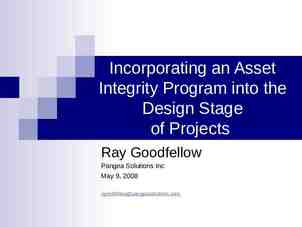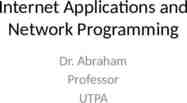Powered Industrial Trucks (PIT) Bureau of Workers’ Compensation
61 Slides1.64 MB

Powered Industrial Trucks (PIT) Bureau of Workers’ Compensation PA Training for Health & Safety (PATHS) OSHA 29 CFR 1910.178 PPT-028-03 1

OSHA Standard for PIT The scope provisions of 1910.178(a) which based on ANSI B56.1-1969 cover: are o Fork trucks, tractors, platform lift trucks, motorized hand trucks and other specialized industrial trucks powered by electric motors or internal combustion engines. o The standard does not apply to compressed air or non-flammable compressed gas-operated industrial trucks, farm vehicles, or vehicles intended primarily for earth moving or over the road hauling. PPT-028-03 2

PIT - Definition A mobile, power-propelled truck used to carry, push, pull, lift, stack, or tier materials (American Society of Mechanical Engineers definition). Vehicles that are used for earth moving and over the road hauling are excluded. PIT’s are commonly known as forklifts, pallet trucks, rider trucks, fork trucks, or lift trucks. Can be powered through electric or combustion engines PPT-028-03 3

Performance Oriented Powered industrial truck operator training requirements are performance oriented. Allows employers to tailor a training program to characteristics of their workplaces and the particular types of powered industrial trucks used. PPT-028-03 4

Forklift Incidents Generally these accidents result from: o Lack of operator training and awareness. o Lack of co-worker awareness (A well known FLT manufacturer recently stated that 60% of injuries/fatalities are sustained by co-workers) o Poor maintenance. o No safe systems of work regarding lift truck operations. PPT-028-03 5

The main risks associated with FLTs are: o Being struck by an FLT. o The FLT rolling over. o Driver being struck by falling items. o Passengers falling off. o Unauthorized start up. o Inadequate braking. o Restricted driver visibility PPT-028-03 6

Operator Training Only trained and authorized operators shall be permitted to operate fork trucks. Employer must ensure training has been provided to include formal instruction (classroom), practical training (hands on), and evaluation. PPT-028-03 7

Operator Training SAFE OPERATION: o The employer shall ensure that each powered industrial truck operator is competent to operate a powered industrial truck safely, as demonstrated by successful completion of the training and evaluation specified in the OSHA standard. o Prior to permitting an employee to operate a powered industrial truck (except for training purposes), the employer shall ensure that each operator has successfully completed the required training (or previously received appropriate training). PPT-028-03 8

Training Program Training shall consist of a combination of: o Formal instruction (e.g. lecture, discussion, interaction, computer learning, written material). o Practical training (demonstrations and exercises performed by the trainee). o Evaluation of the operator’s performance in the workplace. PPT-028-03 9

Training Program Training and evaluation shall be conducted by a person with the knowledge, training, and experience to instruct powered industrial truck operators and evaluate their competence. PPT-028-03 10

Training Program Content o PIT Operators shall receive initial training in the following topics (excepting topics that the employer can demonstrate are not applicable to safe operation in the employer’s workplace): TRUCK RELATED TOPICS WORKPLACE RELATED TOPICS REQUIREMENTS OF THE STANDARD PPT-028-03 11

Training Program Content TRUCK RELATED TOPICS: o Operating instructions, warnings, precautions o Differences from an automobile o Controls and instrumentation o Engine or motor operation o Steering and maneuvering o Visibility PPT-028-03 12

Training Program Content TRUCK RELATED TOPICS: o Fork and attachment adaptation, operation, and use o Vehicle capacity and stability o Vehicle inspection/maintenance operator will perform o Operating limitations o Other instructions, etc. PPT-028-03 13

Training Program Content WORKPLACE RELATED TOPICS: o Surface conditions o Composition and stability of loads o Load manipulation, stacking, un-stacking o Pedestrian traffic o Narrow aisles, restricted areas PPT-028-03 14

Training Program Content WORKPLACE RELATED TOPICS: o Operating in hazardous locations o Operating on ramps and sloped surfaces o Potentially hazardous environmental conditions o Operating in closed environments or other areas where poor ventilation or maintenance could cause carbon monoxide or diesel exhaust buildup PPT-028-03 15

Training Program Content THE REQUIREMENTS OF THE OSHA STANDARD MUST ALSO BE INCLUDED IN THE INITIAL OPERATOR TRAINING PROGRAM! PPT-028-03 16

Refresher Training/Evaluation o Refresher training, including evaluation of effectiveness of that training, shall be conducted to ensure the operator has the knowledge and skills needed to operate the powered industrial truck safely. o Refresher training is required when: ۰ Unsafe operation ۰ Accident or near-miss ۰ Evaluation indicates a need ۰ Different type of equipment is introduced ۰ Workplace condition changes PPT-028-03 17

Refresher Training/Evaluation o An evaluation of each powered industrial truck operator’s performance must be conducted: ۰ After initial training ۰ After refresher training ۰ At least once every three (3) years PPT-028-03 18

Avoiding Duplicate Training If operator has previously received training in a topic specified in this section, and: o Training is appropriate to the truck and working conditions encountered o Additional training in that topic is not required o If operator has been evaluated and found competent to operate the truck safely. PPT-028-03 19

Training Program Implementation Trainees may operate a powered industrial truck only: o Under direct supervision of a person who has the knowledge, training, and experience to train operators and evaluate their competence; and o Where such operation does not endanger the trainee or other employees. PPT-028-03 20

Pre-Operational Inspection o Fluid levels/pressures o Horns/alarms o Leaks o Mast/forks o Steering o Gauges/controls o Fuel/battery level o Hoses/belts/cables o Tires o Safety equipment NOTE: If the FLT is used 24-hours-a-day, it must also be inspected at the end of each shift. PPT-028-03 21

Forklift Components PPT-028-03 22

Stability Triangle PPT-028-03 23

3-Point Suspension o The center of gravity for a FLT moves depending on the load & how its positioned, acceleration, braking & turning. o As long as the center of gravity remains inside the triangle formed by these three points, the vehicle should be stable. o Once the center of gravity moves outside this triangle, the vehicle will tip over. PPT-028-03 24

Vertical Stability PPT-028-03 25

Load Center o Keep the load resting against the vertical face of the forks. o For every 1” past Load Center Loss of 100lbs. of lifting capacity. PPT-028-03 26

Steering: Forklift vs Auto Automobile Forklift PPT-028-03 27

Stability of PIT o Appendix A provides non-mandatory guidance to assist employers in implementing the standard. o This appendix does not add to, alter, or reduce the requirements of this section. PPT-028-03 28

Certification The employer shall certify that each operator has been trained and evaluated as required by the standard. Certification shall include: Name of the Operator Date of the Training Date of the Evaluation Identity of instructor/evaluator PPT-028-03 29

Batteries CHANGING AND RECHARGING BATTERIES: o Changing and/or charging must be located in designated areas for that purpose. o Area must have facilities to flush and neutralize spilled electrolyte. o Eyewashes and showers must be available. o Must have adequate fire protection. o “No smoking” in charging area. PPT-028-03 30

Batteries o Must protect chargers from vehicle damage. o Must adequately ventilate for vapors from gassing batteries: Hydrogen gas emitted Very flammable o Overhead hoist or equivalent must be used to handle batteries. o Wear appropriate PPE (Apron, gloves, face shield, goggles, etc.) PPT-028-03 31

Batteries o A carboy tilter or siphon must be provided for handling electrolyte. o Pour acid into water not vice versa. o Open battery cover or compartment to dissipate heat. o Prevent any open flames, sparks, or electric arcs in battery charging areas. PPT-028-03 32

Refueling o The greatest danger with refueling your FLT is fire. o Turn off the engine and any lights. o Do not smoke and make sure there are no open flames near your FLT. o Be sure there is contact between the spout and the fill pipe before pumping o If fuel is spilled, clean it up. o If you are using a container, make sure it is an approved container PPT-028-03 33

Propane Refueling o Propane is a flammable, compressed gas. o Do not smoke and make sure there are no open flames near your FLT. o Make sure you are wearing the proper PPE (gloves, safety glasses, etc.) PPT-028-03 34

Propane Refueling o Before replacing an LP gas tank, close the shut off valve and let the engine run until it stalls. o Turn off the engine and any lights. o Check for damage to connections and look for leaks. o Propane leaks can be detected by: Distinct odor Hissing sound Frost on fittings PPT-028-03 35

Propane Refueling o Warning: Since LP gas is heavier than air, make sure there is plenty of ventilation before changing or refilling LP tanks. PPT-028-03 36

Lighting o Fork trucks must have lights on both ends where general lighting is less than 2 lumens per square foot. PPT-028-03 37

Data Plate A properly loaded forklift does not exceed the rate capacity of the truck as listed on the truck’s data plate Capacity Load Center Modifications & Attachments PPT-028-03 38

Truck Operations o Trucks shall not be driven up to anyone standing in front of a bench/other fixed object. o No person shall be allowed to stand or pass under the elevated portion of any truck. o Only the operator shall be permitted to ride unless additional seats/seatbelts are provided. o If a truck is parked on an incline, the wheels shall be chocked/blocked. o Operate the forklift from the operator’s seat only. o Stay inside the forklift – overhead guard is for operator protection PPT-028-03 39

Truck Operations o Employees are required to keep arms and legs from being placed between the uprights of the mast or outside the running lines of the truck and must also wear seatbelts (as applies). o Keep stored materials at least 18 inches below sprinklers and away from lights and pipes. PPT-028-03 40

Truck Operations o On an unattended truck, the load shall be fully lowered, controls neutralized, power shut off, and the brake set. o Fork trucks shall not be used for opening or closing freight doors. o The flooring of trucks, trailers, and railroad cars must be checked for holes or weaknesses before entering. PPT-028-03 41

Truck Operations Picking Up A Load o Make sure the load does not exceed the capacity of your FLT. o Make sure the forks are positioned properly. o Make sure the load is balanced & secure. o Check for overhead obstructions. o Raise the forks to proper height. PPT-028-03 42

Truck Operations Picking Up A Load (continued) o Drive into the load as far as possible. o Tilt the load back slightly & then lift it. o Back & lower the load to 2-4 inches from the floor before moving. PPT-028-03 43

Truck Operations Traveling With A Load o Pedestrians always have the right-of-way. o Never allow anyone to ride on your FLT. o Always watch where you are going. o Keep the forks low, 2-4 inches above the floor but do NOT exceed 8 inches. o Keep the load tilted back slightly. o Always drive at a safe speed & slow down when going around corners PPT-028-03 44

Truck Operations Traveling With A Load o All traffic regulations must be observed. o Three truck lengths away from truck ahead. o Stunt driving, racing, horseplay never permitted. o Must drive slowly when floor is wet. o Never run over loose objects on the roadway. PPT-028-03 45

Truck Operations Traveling With A Load o Only loads within rated capacity should be moved. o o Fork trucks with defective parts must be removed from service until repaired. o Speed shall be reduced to a safe level while negotiating turns. o Only stable or safely arranged loads shall be handled. o Cross railroad tracks diagonally PPT-028-03 46

Truck Operations Placing the Load o Stop the FLT completely before raising the load. o Move slowly with the load raised. o Never walk or stand under a raised load. o Tilt the load forward only when over a stack or rack. PPT-028-03 47

Truck Operations Placing the Load (continued) o Be certain the forks clear the pallet before turning or changing height. o Always stack the load square & straight. o Before backing, check behind & on both sides for pedestrians or other traffic. o Unusually shaped loads, such as rolls, may require special stacking. Be aware of requirements before picking up these loads. PPT-028-03 48

Truck Operations Entering a Trailer, Truck or Railcar o Make sure the trailer, truck or railcar has been secured. o Countless injuries & deaths have occurred when a vehicle has rolled away from the dock as a forklift was driving into it. PPT-028-03 49

Truck Operations Entering a Trailer, Truck or Railcar Check: o Dock plate o Trailer floor o Chocks o ICC bar or any other restraint devices present o Jacks (if trailer is not coupled to a tractor) o Dockboard o Dock lock PPT-028-03 50

Additional Requirements o When grades are more than 10%, loaded trucks shall be driven with the load upgrade. o Only safely arranged loads should be handled. o Do not operate trucks with leaks in their fuel systems. PPT-028-03 51

Forklift Hazards PPT-028-03 52

Forklift Hazards Tipping Over o Do not jump off o Stay in the forklift o Hold onto the steering wheel o Brace your feet o Lean away from the fall PPT-028-03 53

Forklift Hazards Pinch Points - Watch where you place your hands and feet. - Stay clear of pinch points. PPT-028-03 54

Forklift Hazards PPT-028-03 55

Forklift Hazards PPT-028-03 56

Free Training Websites Website provides free self-paced on-line training for Fork Lift Operators: http://www.freetraining.com/osha/forklift/forkmenu.htm. The following site also has information on safe forklift operation: http://www.clarkmhc.com/safety/new.SafetyLiftTru cks.asp. (click on topic of interest on right hand side of page). PPT-028-03 57

Things to Remember o Any Powered Industrial Truck operator should receive the appropriate training before they operate the equipment (which includes emphasizing seatbelt use as it applies). o Other PIT operators should be “certified” and a method should be established to prove their certification to any inspectors. o PIT operators should be evaluated by a qualified person at least every 3 years after their initial training/certification, and this evaluation should be documented. PPT-028-03 58

Think Safety!!! PPT-028-03 59

Health & Safety Training Specialists 1171 South Cameron Street, Room 324 Harrisburg, PA 17104-2501 (717) 772-1635 [email protected] Like us on Facebook! https://www.facebook.com/BWCPATHS PPT-028-03 60

Questions PPT-028-03 61


